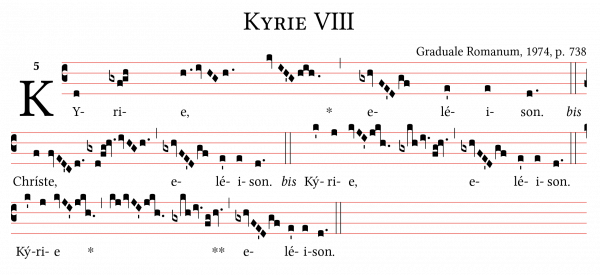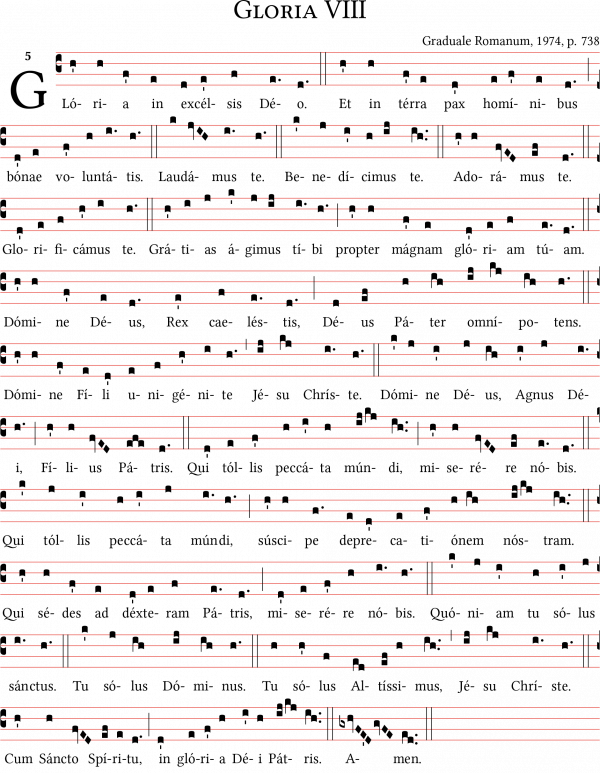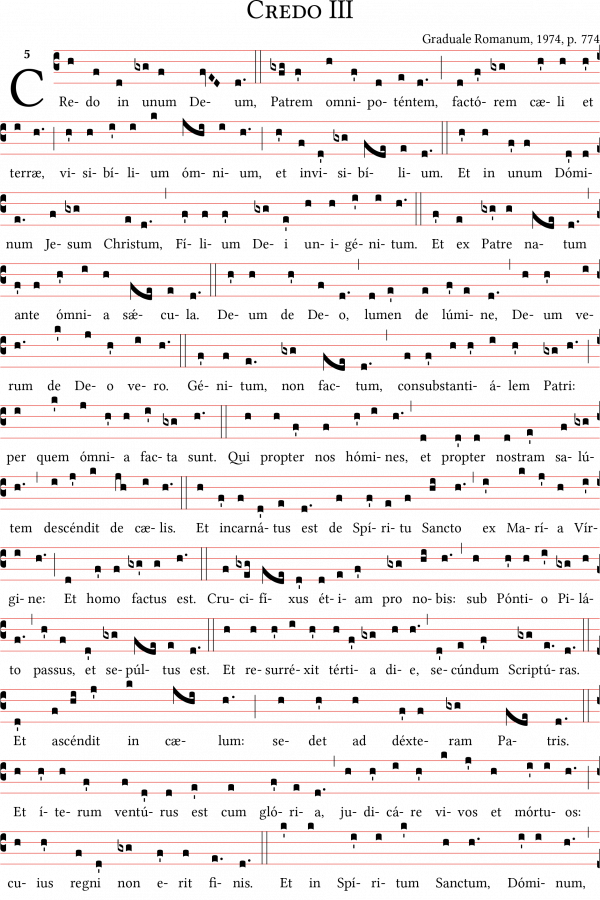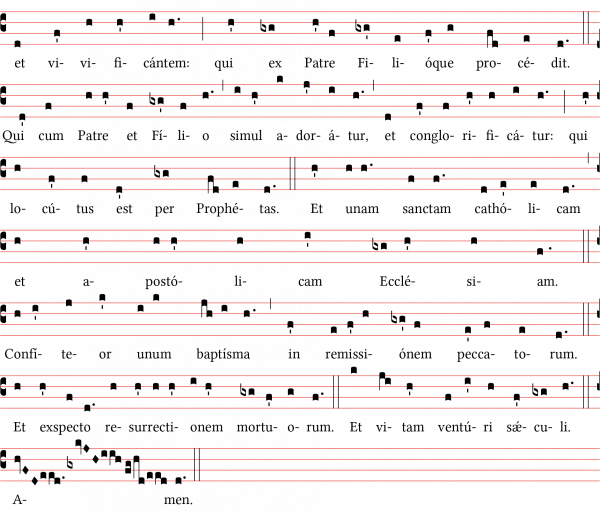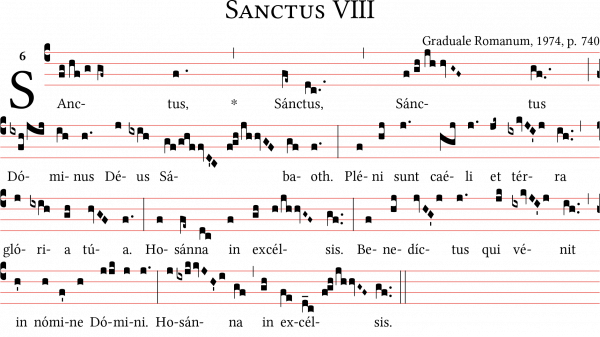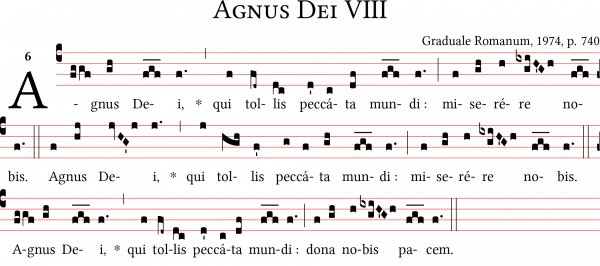Differenze tra le versioni di "Missa VIII (Missa de Angelis)"
| Riga 9: | Riga 9: | ||
|}</center><!-- Fine Donazione --> | |}</center><!-- Fine Donazione --> | ||
<br /> | <br /> | ||
| + | <tabs> | ||
| + | <tab name="ITA"> | ||
La '''Missa De Angelis''', o '''Missa VIII''', è forse la più conosciuta anche fra le assemblee che non hanno spesso a che fare con il Canto Gregoriano. Riporta normalmente l'indicazione '''In festis duplicibus''' (in latino: ''Feste doppie''), viene eseguita generalmente nelle Solennità. | La '''Missa De Angelis''', o '''Missa VIII''', è forse la più conosciuta anche fra le assemblee che non hanno spesso a che fare con il Canto Gregoriano. Riporta normalmente l'indicazione '''In festis duplicibus''' (in latino: ''Feste doppie''), viene eseguita generalmente nelle Solennità. | ||
Come tutte le Messe raccolte nel ''Kyriale Romanum'', è una Messa i cui brani sono stati assemblati dopo che furono composti e cantati per anni. I secoli di composizione dei cinque canti dell' ''Ordo Missae'' (che sono il ''Kyrie'', il ''Gloria'', Il ''Sanctus-Benedictus'' e l' ''Agnus Dei'', il ''Credo'' fu inserito successivamente) sono indicati nello stesso ''Kyriale'': il ''Kyrie'' è del XV-XVI sec. (V modo); il ''Gloria'' del XVI (V modo); Il ''Sanctus'' dell'XI o XII sec. (VI modo); l'''Agnus Dei'' del XV (VI modo). Il ''Credo'' normalmente inserito nella Missa De Angelis, è il ''Credo III'' (V modo), ed è addirittura del XVII sec.<ref>''Kalos concentus'', sito di cultura medioevale; http://www.kalosconcentus.org/index.php/it/gregoriano/missa-de-angelis, url consultato il 26/07/2019</ref> | Come tutte le Messe raccolte nel ''Kyriale Romanum'', è una Messa i cui brani sono stati assemblati dopo che furono composti e cantati per anni. I secoli di composizione dei cinque canti dell' ''Ordo Missae'' (che sono il ''Kyrie'', il ''Gloria'', Il ''Sanctus-Benedictus'' e l' ''Agnus Dei'', il ''Credo'' fu inserito successivamente) sono indicati nello stesso ''Kyriale'': il ''Kyrie'' è del XV-XVI sec. (V modo); il ''Gloria'' del XVI (V modo); Il ''Sanctus'' dell'XI o XII sec. (VI modo); l'''Agnus Dei'' del XV (VI modo). Il ''Credo'' normalmente inserito nella Missa De Angelis, è il ''Credo III'' (V modo), ed è addirittura del XVII sec.<ref>''Kalos concentus'', sito di cultura medioevale; http://www.kalosconcentus.org/index.php/it/gregoriano/missa-de-angelis, url consultato il 26/07/2019</ref> | ||
| + | </tab> | ||
| + | <tab name="ENG"> | ||
| + | The M'''issa De Angelis''', or '''Missa VIII''', is perhaps the best known even among the assemblies that do not often have to do with Gregorian Chant. It normally bears the indication '''In festis duplicibus''' (Latin: ''Double Feasts''), and is generally performed on Solemnities. | ||
| + | |||
| + | Like all the Masses collected in the ''Kyriale Romanum'', it is a Mass whose pieces were assembled after years of being composed and sung. The centuries of composition of the five cantos of the ''Ordo Missae'' (which are the ''Kyrie'', the ''Gloria'', the ''Sanctus-Benedictus'' and the ''Agnus Dei'', the ''Credo'' was inserted later) are indicated in the same ''Kyriale'': the ''Kyrie'' is from the 15th-16th sec. (V mode); the ''Gloria'' of the XVI (fifth mode); The ''Sanctus'' of the 11th or 12th century. (VI mode); the ''Agnus Dei'' of the XV (VI mode). The ''Credo'' normally included in the ''Missa De Angelis'' is the '''Credo III''' (V mode), and is actually from the 17th century.<ref>''Kalos concentus'', sito di cultura medioevale; http://www.kalosconcentus.org/index.php/it/gregoriano/missa-de-angelis, url consultato il 26/07/2019</ref> | ||
| + | </tab> | ||
| + | </tabs> | ||
== Kyrie VIII == | == Kyrie VIII == | ||
Versione delle 15:20, 7 feb 2024
La Missa De Angelis, o Missa VIII, è forse la più conosciuta anche fra le assemblee che non hanno spesso a che fare con il Canto Gregoriano. Riporta normalmente l'indicazione In festis duplicibus (in latino: Feste doppie), viene eseguita generalmente nelle Solennità.
Come tutte le Messe raccolte nel Kyriale Romanum, è una Messa i cui brani sono stati assemblati dopo che furono composti e cantati per anni. I secoli di composizione dei cinque canti dell' Ordo Missae (che sono il Kyrie, il Gloria, Il Sanctus-Benedictus e l' Agnus Dei, il Credo fu inserito successivamente) sono indicati nello stesso Kyriale: il Kyrie è del XV-XVI sec. (V modo); il Gloria del XVI (V modo); Il Sanctus dell'XI o XII sec. (VI modo); l'Agnus Dei del XV (VI modo). Il Credo normalmente inserito nella Missa De Angelis, è il Credo III (V modo), ed è addirittura del XVII sec.[1]
The Missa De Angelis, or Missa VIII, is perhaps the best known even among the assemblies that do not often have to do with Gregorian Chant. It normally bears the indication In festis duplicibus (Latin: Double Feasts), and is generally performed on Solemnities.
Like all the Masses collected in the Kyriale Romanum, it is a Mass whose pieces were assembled after years of being composed and sung. The centuries of composition of the five cantos of the Ordo Missae (which are the Kyrie, the Gloria, the Sanctus-Benedictus and the Agnus Dei, the Credo was inserted later) are indicated in the same Kyriale: the Kyrie is from the 15th-16th sec. (V mode); the Gloria of the XVI (fifth mode); The Sanctus of the 11th or 12th century. (VI mode); the Agnus Dei of the XV (VI mode). The Credo normally included in the Missa De Angelis is the Credo III (V mode), and is actually from the 17th century.[2]
Indice
Kyrie VIII
Spartiti musicali
Spartito gregoriano, impaginato su foglio formato A4:
Spartito disponibile in formato PDF impaginato su foglio A4, Media:KyrieVIII.pdf
Codice Sorgente GABC
name:Kyrie VIII (forma ordinaria); office-part:Kyriale; mode:5; book:Graduale Romanum, 1974, p. 738; commentary:XV-XVI. s.; %% (c3) KY(d)ri(gxf!gh )e,(h.ivHGh.) (kvIH'Ghih.) *(,) e(gxhvFE'Dgf)lé(e')i(e)son.(d.) <i>bis</i>(::z) Chrí(f)ste,(fvED'Cd.gxd!fg!hv./ivHGh.) (,) e(gxhvFE'Dgf)lé(e')i(e)son.(d.) <i>bis</i>(::) Ký(k')ri(j)e,(kvJI'jkh. gxkhiv.fg!hv.) (,) e(gxhvFE'Dgf)lé(e')i(e)son.(d.) (::z) Ký(k')ri(j)e(kvJI'jkh.) *(,) (kj/kvJI'jkh. gxkhiv.fg/hv.) **(,) e(gxhvFE'Dgf)lé(e')i(e)son.(d.) (::)
Gloria VIII
Spartiti musicali
Spartito gregoriano, impaginato su foglio formato A4:
Spartito disponibile in formato PDF impaginato su foglio A4, Media:GloriaVIII.pdf
Codice Sorgente GABC
name:Gloria VIII; office-part:Kyriale; mode:5; book:Graduale Romanum, 1961, p. 29* & The Liber Usualis, 1961, p. 37 & Chants of the Church, 1956, p. 19; transcriber:Andrew Hinkley; commentary:XVI. s.; %% (c3) GLó(h')ri(h)a(f') in(e) ex(d)cél(e')sis(f) Dé(e.)o.(d.) (::) Et(h') in(h) tér(f')ra(e) pax(d') ho(e)mí(f')ni(e)bus(d.) (;z) bó(d')nae(e) vo(f')lun(h)tá(i.)tis.(h.) (::) Lau(k)dá(jvIH)mus(i.) te.(h.) (::) Be(k')ne(j)dí(i')ci(h)mus(ij) te.(ih..) (::) A(h')do(h)rá(fvED)mus(ef) te.(d.) (::z) Glo(d')ri(e)fi(f)cá(h')mus(i) te.(h.) (::) Grá(h')ti(i)as(j) á(k')gi(j)mus(ij) tí(i.)bi(h.) (;) prop(h')ter(h) má(f')gnam(e) gló(d')ri(e)am(f) tú(e.)am.(d.) (::z) Dó(h')mi(h)ne(f') Dé(e)us,(d.) Rex(e') cae(f)lés(e.)tis,(d.) (;) Dé(d)us(ef) Pá(h)ter(ih) om(ij)ní(kj)po(ih)tens.(h.) (::z) Dó(h')mi(h)ne(f') Fí(e)li(d') u(e)ni(f)gé(h')ni(i)te(h.) (,) Jé(ij)su(kj) Chrís(i.)te.(h.) (::) Dó(k')mi(j)ne(i') Dé(j)us,(ih) A(i')gnus(j) Dé(i.)i,(h.) (;) Fí(h')li(h)us(fvED) Pá(efe)tris.(d.) (::) Qui(d') tól(e)lis(f') pec(h)cá(i')ta(h) mún(ij/kj)di,(ih..) (;) mi(h')se(h)ré(fvED)re(ef) nó(e.)bis.(d.) (::z) Qui(k') tól(j)lis(i') pec(h)cá(i')ta(j) mún(i.)di,(h.) (;) sú(h')sci(h)pe(f.) de(e)pre(d')ca(e)ti(f')ó(h)nem(ih) nós(ij/kj)tram.(ih..) (::z) Qui(h') sé(h)des(f') ad(e) déx(d')te(e)ram(f) Pá(e.)tris,(d.) (;) mi(d')se(e)ré(f')re(h) nó(i.)bis.(h.) (::) Quó(k')ni(j)am(i') tu(h) só(i')lus(j) sán(i.)ctus.(h.) (::) Tu(k') só(j)lus(ih) Dó(ij)mi(ih)nus.(h.) (::) Tu(h) só(h')lus(f) Al(ed)tís(ef)si(h)mus,(ih..) (,) Jé(ij)su(kj) Chrí(i.)ste.(h.) (::z) Cum(h') Sán(h)cto(fvED) Spí(ef)ri(e)tu,(d.) (;) in(d') gló(e)ri(f')a(h) Dé(i')i(h) Pát(ij/kj)ris.(ih..) (::) A(gxhvFE'DgvFE)men.(ed..) (::)
Credo III
Spartiti musicali
Spartito gregoriano, impaginato su foglio formato A4:
Spartito disponibile in formato PDF impaginato su foglio A4, Media:CredoIII.pdf
Codice Sorgente GABC
name:Credo III; office-part:Kyriale; mode:5; book:Graduale Romanum, 1961, p. 64* & The Liber Usualis, 1961, p. 68 & Chants of the Church, 1956, p. 50; transcriber:Andrew Hinkley; Stefano Ferri; commentary:XVII. s.; %% (c3) CRe(h)do(f) in(d) u(gxg)num(f) De(fvED)um,(d.) (::) Pa(gxfg)trem(f') om(h)ni(f')po(d)tén(e)tem,(d.) (;) fac(d)tó(f')rem(gxg) cæ(h')li(h) et(h') ter(i)ræ,(h.) (;) vi(h')si(h)bí(i')li(i)um(k) óm(jhi)ni(i)um,(h.) (;) et(h') in(f)vi(d')si(gxg)bí(fde)li(e)um.(d.) (::) Et(h') in(h) u(f')num(f) Dó(d')mi(d)num(e.) Je(f)sum(gxg) Chri(e)stum,(d.) (,) Fí(f')li(f)um(f') De(gxg)i(e') un(h)i(h)gé(i')ni(i)tum.(h.) (::) Et(f') ex(e) Pa(gxg')tre(g) na(fde)tum(d.) (,z) an(f')te(f) óm(h')ni(i)a(h) sǽ(fde)cu(e)la.(d.) (::) De(h')um(h) de(h') De(f)o,(d.) (,) lu(d)men(e') de(e) lú(f')mi(e)ne,(d.) (,) De(h)um(h') ve(i)rum(h.) de(k') De(j)o(h') ve(i)ro.(h.) (::) Gé(f')ni(f)tum,(e.) non(gxg) fac(fde)tum,(d.) (,) con(f)sub(f')stan(h)ti(h')á(i)lem(h') Pa(gxg)tri:(h.) (;z) per(i) quem(k') ó(j)mni(h')a(h) fac(i')ta(gxg) sunt.(h.) (::) Qui(h) pro(h)pter(f') nos(f) hó(h')mi(i)nes,(h.) (,) et(d) prop(d')ter(d) nos(d)tram(e') sa(f)lú(gxg)tem(h.) (,) de(i)scén(j')dit(k) de(jh) cæ(i)lis.(h.) (::) Et(h) in(f')car(f)ná(d')tus(e) est(d.) de(f) Spí(f')ri(e)tu(f) Sanc(hi)to(h.) (,) ex(i') Ma(k)rí(j')a(h) Vír(i')gi(i)ne:(h.) (;) Et(d) ho(f')mo(f) fac(gxg')tus(g) est.(h.) (::) Cru(f)ci(gxeg)fí(fde)xus(d') ét(d)i(e)am(f') pro(gxg) no(hi)bis:(h.) (,) sub(h) Pón(h')ti(h)o(i') Pi(gxg)lá(h)to(f.) (,) pas(h')sus,(f) et(d') se(gxg)púl(fde)tus(e) est.(d.) (::) Et(h) re(h)sur(h')ré(i)xit(h') tér(h)ti(f')a(gxg) di(h)e,(h.) (,) se(d')cún(e)dum(f') Scrip(gxg)tú(e.)ras.(d.) (::z) Et(d') a(f)scén(hi)dit(j') in(k) cæ(jhi)lum:(h.) (;) se(h)det(h') ad(h) déx(f')te(f)ram(gxg) Pa(fde)tris.(d.) (::z) Et(h) í(h')te(h)rum(f') ven(f)tú(d')rus(d) est(e') cum(e) gló(f')ri(e)a,(d.) (,) ju(h)di(h')cá(i)re(h') vi(k)vos(j') et(h) mór(i')tu(i)os:(h.) (;) cu(h)ius(h') re(f)gni(d') non(gxg) e(f')rit(f) fi(e.)nis.(d.) (::) Et(k') in(k) Spí(i')ri(i)tum(k') Sanc(h)tum,(h.) Dó(i')mi(i)num,(h.) (,z) et(d) vi(f')vi(h)fi(h')cán(i)tem:(h.) (;) qui(h') ex(gxg) Pa(h')tre(f) Fi(gxg')li(e)ó(f')que(g) pro(fd)cé(e)dit.(d.) (::z) Qui(d') cum(f) Pa(h)tre(h') et(f) Fí(gxg')li(f)o(h.) (,) si(i)mul(h') a(k)dor(j')á(i)tur,(h.) (,) et(d) con(f')glo(f)ri(h')fi(h)cá(i)tur:(h.) (;) qui(h') lo(h)cú(f')tus(f) est(d') per(gxg) Pro(fd)phé(e)tas.(d.) (::) Et(h') u(h)nam(h.) sanc(f)tam(f.) ca(d)thó(e')li(e)cam(d.) (,z) et(h) a(h')pos(h)tó(h')li(h)cam(i') Ec(gxg)clé(h')si(h)am.(f.) (::) (z) Con(h)fí(i')te(j)or(k') u(i)num(k) bap(jh)tís(i)ma(h.) (,) in(f') re(e)mis(f')si(h)ó(gxg')nem(f) pec(e')ca(f)to(e)rum.(d.) (::z) Et(h) ex(h')spec(f)to(d.) re(h)sur(h')re(h)cti(h')o(i)nem(h') mor(gxg)tu(f')o(g)rum.(f.) (::) Et(k) vi(ji)tam(h') ven(f)tú(i')ri(h) sǽ(f')cu(gxg)li.(h.) (::z) A(hvFDeed.gxkvJHiih//fg/hd/eed)men.(d.) (::)
Sanctus VIII
Spartiti musicali
Spartito gregoriano, impaginato su foglio formato A4:
Spartito disponibile in formato PDF impaginato su foglio A4, Media:SanctusVIII.pdf
Codice Sorgente GABC
name:Sanctus VIII; office-part:Kyriale; mode:6; book:Graduale Romanum, 1961, p. 30* & The Liber Usualis, 1961, p. 38 & Chants of the Church, 1956, p. 21; transcriber:Andrew Hinkley; commentary:(XI) XII. s.; %% (c4) SAnc(fg/hf/ggf~)tus,(f.) *(,) Sánc(fe~)tus,(dc..) (,) Sánc(f/gh/jhhvG~F~)tus(gf..) (;z) Dó(ixfh/jij)mi(ih)nus(h.) Dé(j)us(ixih) Sá(gf/ghffvD'C f!gh/jhhvGF)ba(gf)oth.(f.) (:) Plé(f)ni(hj) sunt(j.) caé(hgj)li(j.) et(jk~) tér(ixkvJI'j)ra(ih..) (,) gló(j)ri(ixih)a(gh) tú(hvGF)a.(f.) (:) Ho(f)sán(fe~)na(dc) in(f) ex(gh)cél(h/jhhvG~F~)sis.(gf..) (:) Be(f)ne(hj)díc(jvHG'j)tus(j.) qui(jk) vé(ixkvJI'j)nit(ih..) (,z) in(h') nó(h)mi(f')ne(h) Dó(jjk)mi(j)ni.(j.) (:) Ho(j)sán(ixjkkvJH'i)na(gf) (,) in(gh) ex(fe)cél(d_c f!gh/jhhvG~F~)sis.(gf..) (::)
Agnus Dei VIII
Spartiti musicali
Spartito gregoriano, impaginato su foglio formato A4:
Spartito disponibile in formato PDF impaginato su foglio A4, Media:AgnusDeiVIII.pdf
Codice Sorgente GABC
name:Agnus VIII; office-part:Kyriale; mode:6; book:Graduale Romanum, 1961, p. 31* & The Liber Usualis, 1961, p. 39 & Chants of the Church, 1956, p. 21; transcriber:Andrew Hinkley; commentary:XV. s.; %% (c4) A(fggf)gnus(gh) De(fgf___)i,(f.) *(,) qui(f) tol(fd~)lis(dc) pec(d')cá(c)ta(df) mun(fgf___)di :(f.) (;) mi(f)se(gh)ré(h)re(ixgiH'Gh) no(fgf___)bis.(f.) (::) A(f)gnus(hj) De(jvHG'j)i,(j.) *(,) qui(j) tol(hgh)lis(f') pec(g)cá(f)ta(gh) mun(fgf___)di :(f.) (;) mi(f)se(gh)ré(h)re(ixgiH'Gh) no(fgf___)bis.(f.) (::z) A(fggf)gnus(gh) De(fgf___)i,(f.) *(,) qui(f) tol(fd~)lis(dc) pec(d')cá(c)ta(df) mun(fgf___)di :(f.) (;) do(f)na(gh) no(h)bis(ixgiH'Gh) pa(fgf___)cem.(f.) (::)
Ite VIII
Spartiti musicali
Spartito gregoriano, impaginato su foglio formato A4:
Spartito disponibile in formato PDF impaginato su foglio A4, Media:Ite-VIII.pdf
Codice Sorgente GABC
name:Ite VIII; office-part:Kyriale; mode:5; book:Graduale Romanum, 1961, p. 31* & The Liber Usualis, 1961, p. 39 & Chants of the Church, 1956, p. 22; transcriber:Andrew Hinkley; %% (c3) I(gxd!f!gh)te,(h.ivHGh.kvIH'Ghih. ,gxhvFE'Dgf) mis(e')sa(e) est.(d.) (::) <sp>R/</sp>. De(gxd!f!gh)o(h.ivHGh.kvIH'Ghih. ,gxhvFE'Dgf) grá(e')ti(e)as.(d.) (::)
Spartito completo
Notazione quadrata
- Spartito gregoriano in notazione quadrata (comprendente KYRIE, GLORIA, CREDO, SANCTUS e AGNUS DEI) disponibile in formato PDF impaginato su foglio A4, Media:MissaDeAngelisGregoriana.pdf
Spartito musicale
- Spartito musicale con accompagnamento, tonalità di Re Maggiore, (comprendente KYRIE, GLORIA, SANCTUS e AGNUS DEI) disponibile in formato PDF impaginato su foglio A4, Media:Missa-VIII.pdf; Link diretto: http://musicaliturgica.altervista.org/partiture/missa-VIII.pdf (© Musica Liturgica - http://musicaliturgica.altervista.org)[3]
Video
Missa VIII De Angelis
Kyrie, Gloria, Sanctus, Agnus Dei, della Missa de Angelis, a pagina 738 del Graduale Romano (1974) eseguita dalla Schola Gregoriana Mediolanensis, direttore Giovanni Vianini, Milano, Italia.
Credo III
Credo III tratto dal Liber Usualis (1961), pp. 68-70 eseguito dai monaci benedettini dell'abbazia di Ganagobie.
Ite VIII
Il canto "Ite missa est" VIII dal canale YouTube DiaconiCantori
Bibliografia
- Kalos concentus, sito di cultura medioevale; http://www.kalosconcentus.org/index.php/it/gregoriano/missa-de-angelis, url consultato il 26/07/2019
- GregoBase project, https://gregobase.selapa.net/
- Graduale Romanum, Libreria Editrice Vaticana 1974
- Liber Usualis, Solesmes 1961.
- MUSICA LITURGICA, http://www.musicaliturgica.altervista.org/, link utilizzato il 27/07/2019.
Note
- ↑ Kalos concentus, sito di cultura medioevale; http://www.kalosconcentus.org/index.php/it/gregoriano/missa-de-angelis, url consultato il 26/07/2019
- ↑ Kalos concentus, sito di cultura medioevale; http://www.kalosconcentus.org/index.php/it/gregoriano/missa-de-angelis, url consultato il 26/07/2019
- ↑ Missa VIII de Angelis, http://www.musicaliturgica.altervista.org/, link utilizzato il 27/07/2019.
